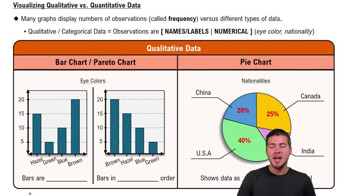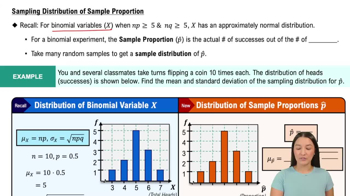Birth Weights Refer to the sample described in Exercise 6. Because Bellevue Hospital Center agreed to provide the 100 birth weights, does the sample of birth weights constitute a voluntary response sample?
Table of contents
- 1. Intro to Stats and Collecting Data1h 14m
- 2. Describing Data with Tables and Graphs1h 55m
- 3. Describing Data Numerically2h 5m
- 4. Probability2h 16m
- 5. Binomial Distribution & Discrete Random Variables3h 6m
- 6. Normal Distribution and Continuous Random Variables2h 11m
- 7. Sampling Distributions & Confidence Intervals: Mean3h 23m
- Sampling Distribution of the Sample Mean and Central Limit Theorem19m
- Distribution of Sample Mean - Excel23m
- Introduction to Confidence Intervals15m
- Confidence Intervals for Population Mean1h 18m
- Determining the Minimum Sample Size Required12m
- Finding Probabilities and T Critical Values - Excel28m
- Confidence Intervals for Population Means - Excel25m
- 8. Sampling Distributions & Confidence Intervals: Proportion1h 25m
- 9. Hypothesis Testing for One Sample3h 29m
- 10. Hypothesis Testing for Two Samples4h 50m
- Two Proportions1h 13m
- Two Proportions Hypothesis Test - Excel28m
- Two Means - Unknown, Unequal Variance1h 3m
- Two Means - Unknown Variances Hypothesis Test - Excel12m
- Two Means - Unknown, Equal Variance15m
- Two Means - Unknown, Equal Variances Hypothesis Test - Excel9m
- Two Means - Known Variance12m
- Two Means - Sigma Known Hypothesis Test - Excel21m
- Two Means - Matched Pairs (Dependent Samples)42m
- Matched Pairs Hypothesis Test - Excel12m
- 11. Correlation1h 6m
- 12. Regression1h 50m
- 13. Chi-Square Tests & Goodness of Fit1h 57m
- 14. ANOVA1h 57m
1. Intro to Stats and Collecting Data
Intro to Stats
Problem 1.RE.2c
Textbook Question
Paying for First Dates USA Today posted this question on the electronic version of its newspaper: “Should guys pay for the first date?” Of the 1148 subjects who decided to respond, 85% of them said “yes.”
c. Does the survey constitute an experiment or an observational study?
 Verified step by step guidance
Verified step by step guidance1
Understand the definitions: An experiment involves manipulating one or more variables to determine their effect on a response variable, while an observational study involves observing subjects without manipulation.
Identify the key elements of the survey: The survey asked a question and recorded responses without manipulating any variables.
Determine if there was any manipulation: In this case, the survey simply collected opinions without altering any conditions or variables.
Recognize the nature of the data collection: Since the survey collected responses based on participants' existing opinions, it aligns with the characteristics of an observational study.
Conclude the type of study: Based on the lack of manipulation and the method of data collection, this survey is an observational study.
 Verified video answer for a similar problem:
Verified video answer for a similar problem:This video solution was recommended by our tutors as helpful for the problem above
Video duration:
2mPlay a video:
Was this helpful?
Key Concepts
Here are the essential concepts you must grasp in order to answer the question correctly.
Experiment vs. Observational Study
An experiment involves manipulating one or more variables to observe the effect on another variable, often with random assignment to treatment groups. In contrast, an observational study involves observing subjects without manipulating any variables, simply recording data as it naturally occurs. Determining whether a study is experimental or observational is crucial for understanding the nature of the conclusions that can be drawn.
Recommended video:
Guided course

Visualizing Qualitative vs. Quantitative Data
Sampling Bias
Sampling bias occurs when the sample collected is not representative of the population intended to be analyzed, often due to non-random selection methods. In the context of surveys, voluntary response bias is a common form of sampling bias, where individuals self-select to participate, potentially skewing results. Recognizing sampling bias is essential for evaluating the reliability and validity of survey findings.
Recommended video:

Sampling Distribution of Sample Proportion
Voluntary Response Sample
A voluntary response sample is a type of non-probability sampling where participants choose to be part of the sample. This method often leads to biased results because those who feel strongly about the topic are more likely to respond, which may not reflect the views of the general population. Understanding this concept helps in assessing the limitations of survey data and the generalizability of its conclusions.
Recommended video:

Sampling Distribution of Sample Proportion

 2:13m
2:13mWatch next
Master Introduction to Statistics Channel with a bite sized video explanation from Patrick
Start learningRelated Videos
Related Practice
Textbook Question
